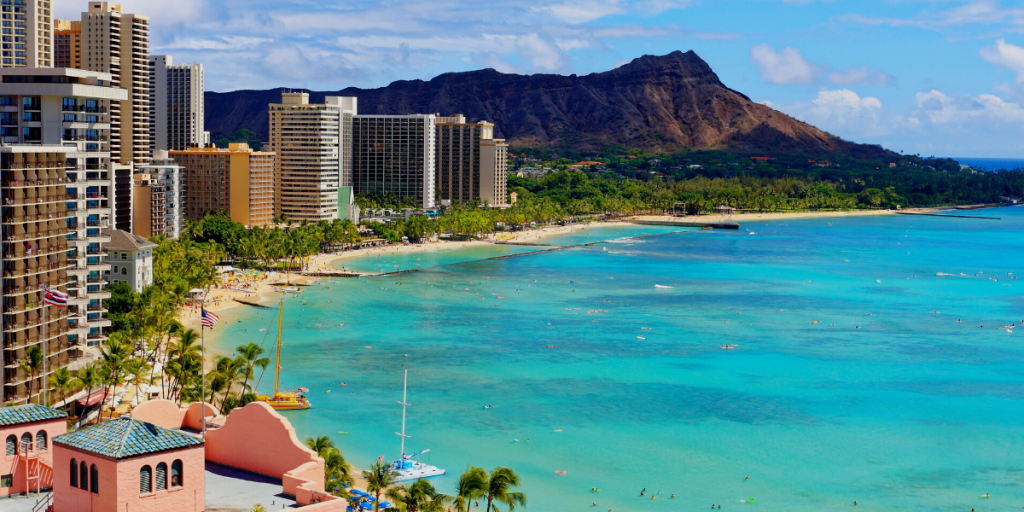The shoreline of Waikiki Beach in Hawaii is one of the most valuable real estate developments in the state. The area is heavily developed, with hotels and resorts all along the beach. Hotels and resorts are built right on the sand, which makes them an important part of Waikiki’s tourism industry and economy. However, this form of coastal development can actually make erosion worse. In Hawaii, 70% of beaches have chronic shoreline erosion.
Did you know that Waikiki is entirely manmade? And yes, it is one of the most valuable real estate developments in Hawaii. The beachfront hotels and resorts that line this famous stretch of sand draw millions of tourists each year, who come to see the beaches and overlooks. Yet like other beaches around the world, it’s experiencing serious coastal erosion.
Read: 4 Impacts of Mass Tourism on The Environment
Because of its importance, in 2006, $500,000 USD was spent to siphon 10,000 cubic yards of offshore sand to be used as replenishment for Waikiki’s beaches. Another replenishment project in 2012 cost between $3 and $4 million, pumping faraway sand to Waikiki’s shores. The shoreline has been eroding for decades because waves and currents have been removing sand from this area, so these projects continue.
Replenishment projects like these are controversial. Obviously, moving around this much sand impacts the creatures that call the ocean their home. According to the University of California, “the sudden input of massive amounts of sand can kill all the animals living on the beach. During nourishment, the beach becomes a major construction zone. The heavy machinery used to truck in and distribute new sand also kills beach animals and disturbs wildlife.”
Yet, climate change and beach development are speeding up the natural rates of erosion on Waikiki’s beaches. These sand nourishment projects will have to be repeated every five to ten years, due to tourism’s demand in the area and on the island itself. When the beaches erode from time and excessive use or development, it makes them less attractive to tourists and causes businesses to lose revenue. Local governments are then inclined to continue pumping in new sand. This also helps protect the fancy developments that line the shoreline from becoming flooded if the coastline were to shift naturally.
Natural erosion occurs when waves crash against rocks or coral reefs near shore, causing sand to be washed away and deposited somewhere else. Shorelines will always move back and forth along their boundaries– this is how beaches form over time! These natural processes are a part of our environment, and they’re not going away anytime soon. But what has changed is that we have developed the area around Waikiki Beach in such a way that it makes erosion worse than it would be otherwise. Changing the landscape of the island with more buildings and tourist infrastructure naturally changes where the water will flow over time.
Coastal erosion can have devastating environmental impacts, including the loss of beaches, destruction of marine habitats, and increased vulnerability to natural disasters. As the shoreline recedes, it can also lead to the destruction of important ecosystems such as coral reefs and mangrove forests. This loss of habitat can have ripple effects throughout the entire marine ecosystem, causing a decline in fish populations and negatively impacting other marine species.
Read: Meet the Mighty Mangroves
As one form of coastal management, revetments have been installed along portions of Waikiki Beach in an attempt to stop further beach loss. Revetments are structures built along the shoreline to protect against erosion. They can be constructed from concrete, rock, or sandbags, and add protection from waves and currents. However, revetments do not always work as intended and can cause beach area loss due to currents pushing them inwards toward land. Revetments are also expensive and time-consuming to install.
It’s really a pressing environmental issue that affects communities all over the world, not just in Hawaii as highlighted here. If you’re interested in learning more about this issue, we encourage you to do your own research by following the links below and exploring the impacts of coastal erosion on the environment, local communities, and tourism.
If you ever intend to travel to Waikiki, it’s important to prioritize sustainable and ethical travel practices by supporting eco-friendly accommodations that prioritize social and environmental justice. By taking the time to educate yourself and make responsible choices, you can help preserve the beauty and cultural significance of Hawaii for generations to come.
Resources & Further Reading
https://www.climatereadyoahu.org
https://www.youtube.com/watch?v=m5KiW67ENvE


